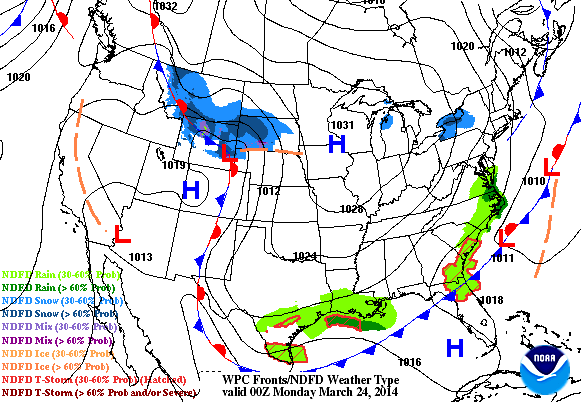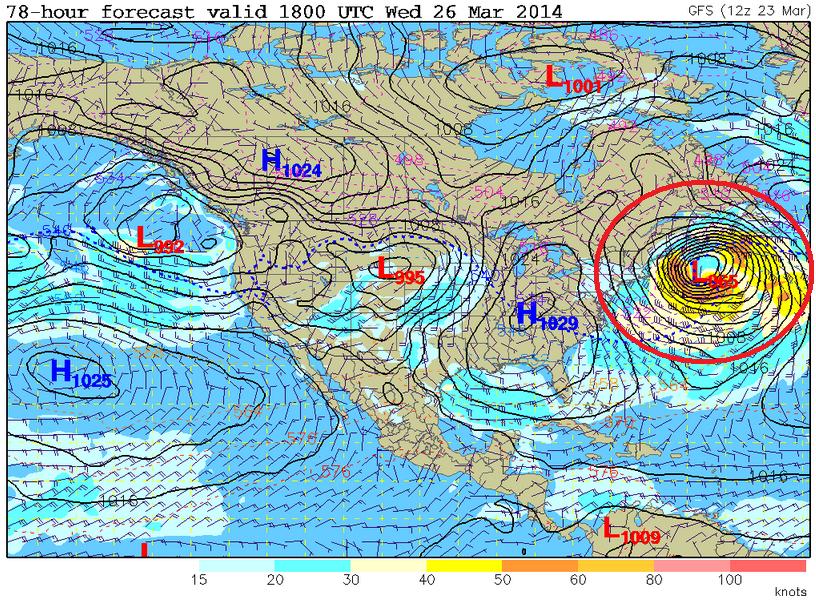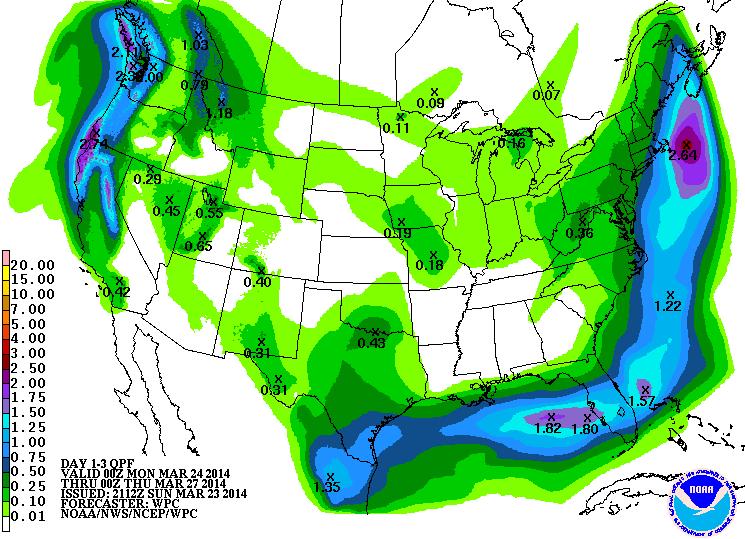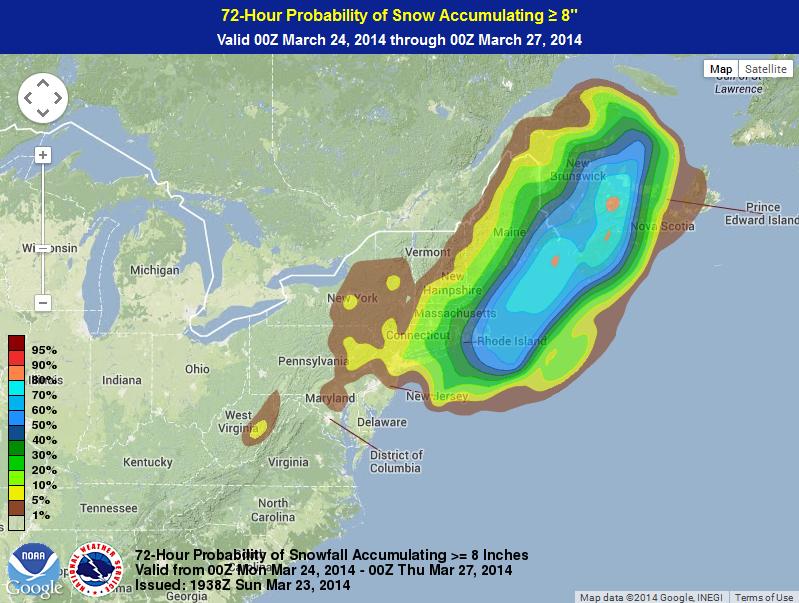Wet System Late Friday/Saturday, Thunderstorms Again Possible
MARCH 27, 2014
What a week it’s been! Two days of supercells in Glenn and Butte counties, with Wednesday having supercells from the northern San Joaquin valley to Glenn/Butte counties. With all the action we've seen, we still aren't done just yet.
Yet another large upper low and associated surface low will push eastward and become quasi-stationary off the Pacific Northwest coast Friday. It has already tapped into a subtropical moisture plume from the Hawaiian Islands, and though not a significant moisture tap, it includes precipitable water values in the 1 – 1.2″ range being transported into OR/CA via a combination of the main Pacific jet and a subtropical jet. This strong/dynamic jet streak energy, moisture, and cold air aloft associated with the upper low will dig the trough further south and enhance a vorticity max off the California coast.

As the vort max pushes toward the California coast Friday night into Saturday, a cold front will slide through bringing a band of moderate to locally heavy rain given the above mentioned moisture and jet dynamics in addition to strong lift. The frontal precipitation band should arrive along the north coast by Friday morning, into the coastal mountains, northern mountains, and northern valley by mid to late-afternoon, and begin filling into the central valley by early to mid-evening. Front slows as it slides further south, and finally reaches the I-80 corridor by the early morning hours of Saturday. The band may stall out from around SFO up the I-80/Highway-50 corridor through at least the late morning hours Saturday, possibly into the afternoon. It should finally arrive in the San Joaquin valley by mid-morning.
Convection could once again be something to keep a close eye on with this system. Given a more noticeable system closer to our coast (in this case the vort max), and a deeper trough, colder air aloft with punch further south compared to storms earlier in the week. -25c 500mb temperatures arrive overhead by the afternoon and evening, which will promote some steepening lapse rates along a leading plume of the cooling upper-level air. Given a 100 – 130kt jet carving through California Saturday, speed shear will be strong, but directional shear is a bit more iffy. The GFS indicates great low-level southeasterly winds and decent southwest to WSW winds at 500mb, while the NAM indicates westerly surface winds and westerly 500mb winds from Yuba City to Stockton… with somewhat in the way of better veering north to Redding. Overall, for now, I’d expect great speed shear and at least modest directional shear.

300mb winds and 500mb heights plotted through the 0z 12km NAM, valid for around 2pm Saturday.
Clearing is again iffy with this setup. If the front exists by early to mid-afternoon in at least half of the Sacramento valley and allows for some partly cloudy skies to develop and boost surface temperatures into the upper 50s to low 60s, buoyancy and CAPE would be sufficient for thunderstorm development again. The NAM indicates MLCAPEs in the 100 – 400 j/kg range Saturday afternoon in the northern San Joaquin valley north to around Chico, and that’s without widespread clearing. If clearing were to occur, CAPE/LIs would be higher than that, and (low-level) lapse rates would also skyrocket.
Forecast mixed-layer CAPE via the 0z 12km NAM, valid for 2pm Saturday.
There is certainly potential for strong thunderstorms Saturday if clearing occurs, but confidence in rotating storms in my opinion needs another day to elapse for models to get a better handle on timing of all the elements.
Aside from convection, snow levels initially with the front Friday night should start out around 6000 – 6500ft, but drop off to around 5000ft later Saturday.
Precipitation totals will range from 1/2 – 1″ of rain in the valley in general, but along the east side of the valley upwards of 1.5″ is possible given decent upsloping/orographics in the sierra banking up against the foothills into the east side. Higher up, the foothills should see anywhere from .75 – 1.5″ in the south, to 1 – 3″ in the central and northern foothills. The western slope of the sierra is expected to pick up 2.5 – 4″ of liquid, locally a bit more in orographically favored areas. .5 – 1.5″ along the coast, with perhaps locally up to or near 2″, and lastly, 1 – 3″ in the coastal and northern mountains. These liquid QPFs would translate to 1 – 2ft of snow above 6000 – 6500ft late Friday – early Sunday.
Forecast QPF via the 0z GFS. 0z NAM/4km NAM came in dryer, thus for now I’ll disregard it’s QPF.
Sunday for the most part should be generally drier, however leftover cold air aloft could support some scattered convection, but nothing widespread/significant is expected.
A larger and stronger low drops out of the Gulf of Alaska over the weekend and winds up off either the Pacific Northwest or OR/CA coast by Monday, and brings another round of rain, snow, and potentially another thunderstorm threat. This system could dump precipitation amounts similar to the Friday/Saturday system, except it’d be a bit cooler, with lower snow levels and more snowfall in the mountains. More information on this over the weekend.
Forecast 500mb relative vorticity and heights valid Monday afternoon, via the 0z GFS.
I’ll have a update out Friday night regarding Saturday’s system, mainly the convective threat, and an update Saturday night for the Monday/Tuesday system, and probably again Sunday night to get a closer look at the possible convective threat Monday. It’s certainly been a busy week, perhaps some early and belated birthday presents given mine is Friday? Probably not, but nonetheless very enjoyable! Stay tuned!
Through the morning Wednesday, an upper level impulse traveling along a rather strong jet impacted northern California, bringing a round of showers to northern California. This upper level system was associated with a upper low off the Pacific Northwest coast, which was in the perfect position in to support decent vertical motion across northern California, along with the associated 100 – 120kt upper level jet.
Visible satellite imagery + radar mosaic from around 1:10, indicating some breaks between developing cumulus in the western central valley.
By early afternoon, a showers subsided in the northern and central Sacramento valley, which promoted partly cloudy skies and allowed surface temperatures to warm into the upper 50s to locally low 60s. At 500mb, temperatures were around -25c in association with the upper low to the north, which combined with ambient surface hearing promoted mid-level lapse rates around 7 and low-level lapse rates in the 8 – 9c range. In addition (and somewhat more importantly), decent moisture in the low/mid-levels combined with good cooling with height allowed for SBCAPE values to rise into the 200 – 500 j/kg range from Sacramento to around Red Bluff, which is sufficient for thunderstorm development in combination with the decent upper-level support and moisture.
Given the proximity to the upper low off the PNW coast and the decent jet blasting overhead, the positioning of the low made for fantastic directional shear Wednesday. Surface winds were out of the south to southeast in the valley Wednesday, and from around 4000 – 5000ft up, they were out of the west-south-west to west, and moderate to strong in speed above 5000 – 10000ft. Surface winds themselves in the central valley Wednesday were breezy from Sacramento to Red Bluff, with gusts in the 20 – 25mph range. The great directional and low-level shear made for noticable clockwise curving hodographs, also supporting the fact that the directional shear again was fantastic.

Take a look at this vertical wind profile from KDAX, the US National Weather Service Sacramento California’s radar site near Davis. The latest profile is on the far right, with the lowest wind barbs being at/near the surface and the highest barb available at/near 18,000ft, in this case. Notice the surface wind barb is out of the southeast, while winds above around 3,000 – 4,000ft and up are from the southwest to west-southwest. These veering winds with height are fantastic for rotating thunderstorms, but we need to get some sunshine in the valley for instability to be sufficient enough to support strong enough thunderstorms to make use of this excellent directional shear.
A forecast hodograph for the central Sacramento valley for Wednesday afternoon.
With these ingredients in place, the probability of strong to tornadic thunderstorms was moderate to high if the sun were to break through – and it did.
By noon to 2pm, the partly cloudy skies in the central valley had lasted long enough and promoted strong enough buoyancy to aid in the development of a thunderstorm in central Glenn county by 2 – 2:30pm.
More than a hour later, the storm finally began to move, which was around 3:30 – 4pm. Once eastward progression began, the storm began rotating more noticeably, and produced it’s first viewed funnel cloud around 4:40pm.
First funnel we and other spotters and chasers spotted around 4:40.
Around 5:30, the supercell finally crossed I-5, and produced at least two more funnels, and possibly one weak touch down. We noticed quite a bit of dust being kicked up in a field in front of us north of SR-162 between Williams and Glenn.
Just a few minutes later, a full condensation funnel made it to the ground west of I-5, and touched off and on for 1500ft according to the NWS in Sacramento’s survey, and was also rated a EF1 given several dozen almond trees were uprooted, along with some damage to outbuildings.
In addition to this and a bunch of other photos, here’s a video we captured of the development of the tornado, and towards the end it either weakens and fades or becomes invisible due to rain wrapping around the mesocyclone. Link to the video via YouTube is below.
During this time, the supercell on radar looked amazing, with a clear hook, BWER, and some rather strong surface inflow.
In this four-panel view, you can see your standard base reflectivity up in the top left, storm-relative velocity in the top right, correlation coefficient in the bottom left, and differential reflectivity in the bottom right. In the bottom left (CC), there is a one pixel that lasted a couple frames of some low values, which which contained within the hook and associated meso, and could have been a small amount of tornaod debris being pulled up high enough to be detected by the radar.
Shortly after this frame, the tornado dissipated, though the storm continued to rotate into western Butte county.
Around the same time, a smaller supercell spawned several funnel clouds and one tornado in Roseville as that supercell tracked from eastern Sacramento county east into Placer county.
This event goes to show, that tornado events do happen in California, and perhaps most commonly in the Sacramento/San Joaquin valleys. The frequency seems to be one to three times per winter/spring, depending on the year.





















































.jpg)





